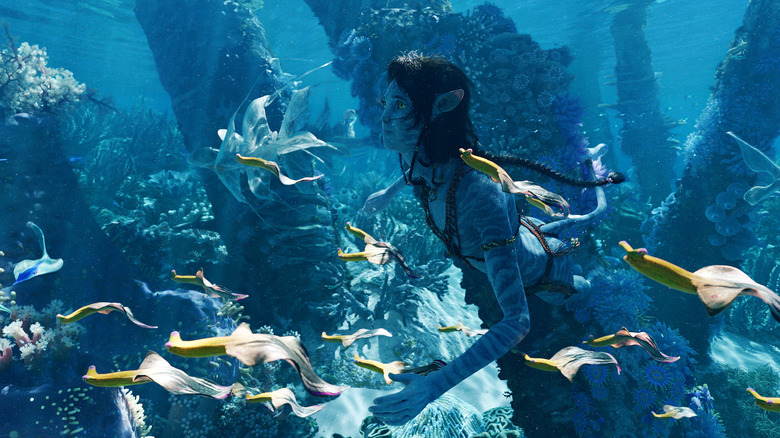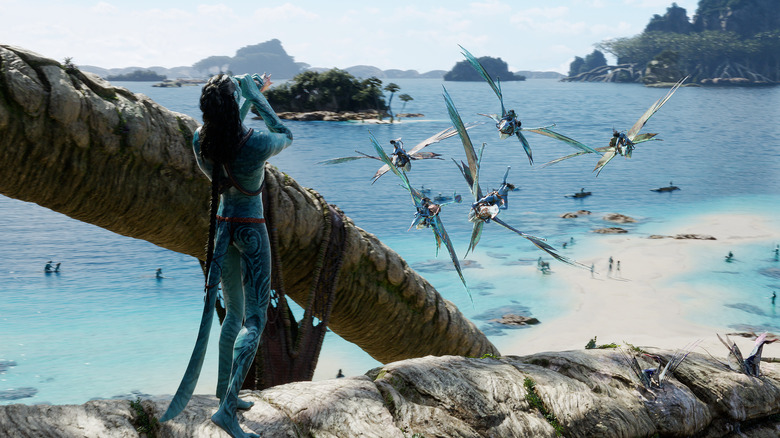Peter Jackson's Lord Of The Rings Inspired James Cameron To Create The World Of Avatar
The "Avatar" movies and the "Lord of the Rings" trilogy have more in common than characters who say "I see you" (maybe Sauron has some Na'vi ancestry). Both were largely filmed in New Zealand, and both were made in collaboration with cutting-edge visual effects studio Weta Digital, now known as Wētā FX. And when it came to filming his "Avatar" sequels, director James Cameron took a leaf out of Peter Jackson's book and shot the movies back-to-back, with "Avatar: The Way of Water," "Avatar 3," and a chunk of "Avatar 4" all going in front of the cameras in one big marathon session.
While Jackson's epic fantasy movies may have released in fairly rapid succession, the filmmaker had been developing his vision for "The Lord of the Rings" since 1995. Individually, the movies' budgets were more modest, but collectively, they were a massive undertaking with a $280 million price tag. Even Cameron, king of movies with ridiculous budgets, couldn't believe Jackson pulled off the pitch.
"Peter and I are pals, [and] I always tell him that was the biggest, craziest bet in movie history," Cameron said in an interview with Deadline. "I think ['Avatar'] is a big bet, a very big bet monetarily, but I think that one was nuts." Moreover, the level of detail that Jackson put into creating Middle-earth was a key inspiration to Cameron for the project that was Pandora:
"They proved the model, and I was fascinated by that and I thought, 'Wow, how cool would it be to go into that level of fractal detail in the worldbuilding around the characters that Tolkien did and that Peter did from Tolkien's books?' It would be great to do that."
A whole new world
This isn't the first time that Cameron has cited "The Lord of the Rings" as one of the benchmarks that he was aiming for with the "Avatar" movies. Interviewed by Robert Rodriguez for Variety, the director described the world of Pandora as an "epic landscape with epic storytelling" and elaborated, "I was trying to emulate a 'Star Wars' universe or 'Lord of the Rings.' Something that's a persistent world that people can come back to and enjoy over time."
The worldbuilding began with designing the look of the Na'vi, their culture, their religion, and their odd physiology with hair braids that double as USB ports, connecting them to the trees and animals of Pandora as well as the mysterious spirit at the heart of the moon, Eywa. But beyond that, "Avatar" and its sequels also introduce audiences to an expansive world of flora and fauna that, thanks to advances in visual effects, could feel immersive and alive. "Avatar: The Way of Water" goes all-in on this worldbuilding, introducing a new clan of Na'vi, the Metkayina, whose skin color and tails vary in appearance from Neytiri and Jake's Omatikaya clan.
Then there are the new animals: tulkun, the intelligent space whales; ilu, the aquatic equivalent of direhorses; skimwings, a sharp-toothed mount that the Metkayina use for hunting. And unlike Jackson, Cameron and his creative team didn't have a detailed tome and appendices to work from. "We had to come up with it ourselves, so that took some time, and that's probably the gap between Movie 1 and Movie 2," Cameron told Deadline. Judging by the A-grade CinemaScore and the box office results so far, it looks like audiences think "Avatar: The Way of Water" was worth the wait.

